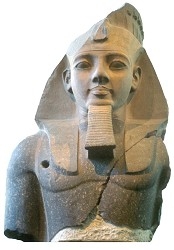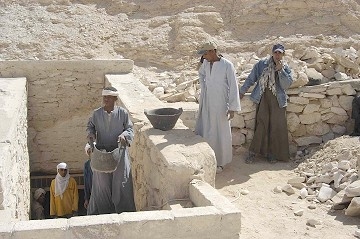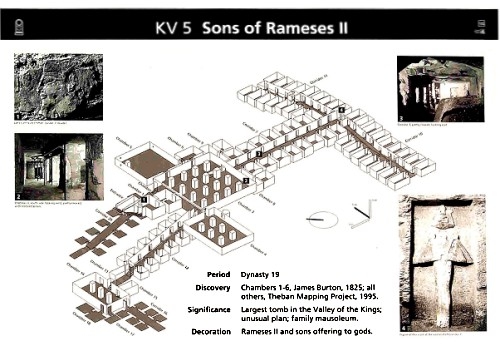The Discovery Channel special Rameses: Wrath of God or Man? aired Sunday, December 5, 2004, [with subsequent re-airings] and suggested the eldest son of Rameses II (the Great) was the firstborn son of the Egyptian Pharaoh killed by the tenth plague. This son’s name is known in history as Amun-her-khepeshef, born of Rameses’ main wife Nefertari, not to be confused with a son of Rameses III of the same name.
Statue of Rameses II from Thebes,
now on display in the British Museum.
 |
The premise of the television special was based on remains found within a rock-carved tomb in the New Kingdom royal burial ground known as the Valley of the Kings, on the Nile’s west bank across from ancient Thebes. Unlike the stone-built pyramids of Egypt’s Old and Middle Kingdoms, Pharaonic tombs in the Valley of the Kings were rock-carved horizontal shafts cut deep into the mountainside. The tomb of interest is named KV5 (King’s Valley #5). First identified in 1825, it was thought to be one of the smaller tombs in the Valley. It had been plundered in antiquity and was considered anonymous. In 1922 Howard Carter buried KV5’s entrance with rubble from King Tutankhamen’s tomb. It was not seen again until 1985, when Egyptologist Kent Weeks re-identified and excavated it as part of the Theban Mapping Project.
Entrance to tomb KV5 in the Valley of the Kings,
Luxor, Egypt. The tomb was built as the burial place
for the numerous sons of Rameses II.
 |
Early in Weeks’ investigation of KV5, he found human remains within a pit inside the second chamber from the entrance. Weeks also identified reliefs carved on the tomb walls tying this tomb to numerous sons of Rameses II. Then in 1995, buried beneath debris in the rear of the tomb, Weeks discovered a long passageway leading to dozens of rooms that had also been plundered in antiquity, but unknown to the modern world until that day. To date, over 140 chambers have been identified and it is now the largest tomb in the Valley of the Kings. With the identification of some 20 names of Rameses II’s sons, Weeks believe this tomb was their common burial place. Because Rameses II ruled for 67 years and probably lived into his 90s, he outlived many of his sons. Apparently he commissioned a massive tomb in the Pharaonic cemetery for these royal princes. The names of 52 of Rameses’ sons are known from other sources and it is possible many of them were laid to rest within this tomb. Rameses II’s own tomb, and that of his son and successor Merneptah (son number 13), are both nearby in the Valley of the Kings.
The human remains Weeks found inside the second chamber included three skulls and one whole skeleton. They were apparently remains of unwrapped and looted mummies left here by ancient tomb robbers. Each may be a royal son. One of the skulls (Skull 2) is believed to belong to Rameses’ oldest son, Amun-her-khepeshef. This identification resulted from a forensic study done earlier in the year by Caroline Wilkinson of Manchester University and was the basis of the Discovery Channel special. Wilkinson’s study was limited to cleaning the skulls, taking cranial measurements and performing computer reconstructions. The Egyptian government would not grant permission for DNA or any other scientific tests on the physical remains.
While Rameses’ sons are named on the tomb walls, interment of other bodies into an existing tomb was a common practice in ancient Egypt. The remains inside the tomb entrance could be such intrusive burials and not the tomb’s intended occupants. Yet, the facial reconstructions do resemble Rameses II’s mummy, now housed in the Egypt Museum in Cairo. At the end of the day, the best Wilkinson could say was that the three skulls fit a high statistical probability of being related to Rameses II.
Given all the evidence, such identification is quite plausible. But everyone in the scientific community knows that DNA tests would be more definitive. It is also well known in the scientific community that the Egyptian government does not allow such tests. While admitting on camera that DNA testing would be conclusive, Weeks gently sidestepped the issue by simply stating, “We’re not ready for that yet.”
Plan of Tomb KV5. With over 140 chambers so far identified,
KV5 is the largest tomb in the Valley of the Kings.
 |
To be honest, it was never clear to me why this one skull (Skull 2) was particularly believed to be that of Amun-her-khepeshef. Neither was it clear from the television special that Weeks believed it either. Just as an aside, DNA testing could be pretty exciting because the mummy of Rameses I was returned to Egypt in the spring of 2004. He is now reunited with the mummies of his son Seti I, his son Rameses II and his son Merneptah, Amun-her-khepeshef’s brother.
A far more difficult case for the Discovery Channel special to make is the identification of Rameses II as the Pharaoh of the Exodus. While narrator Morgan Freeman duly stated after every commercial break that Rameses II might be the Pharaoh of the Exodus, the program simply went ahead assuming it was fact. Sound bites from Egyptologist Kenneth Kitchen (who does accept the Rameses II connection) and Israeli archaeologist Israel Finkelstein (who does not believe there was an Exodus, period) were used to bolster their case.
While his remarkable reign covered most of the 13th century BC (1279-1212 BC), Rameses II came too late for Israel’s Exodus from Egypt. According to the Bible’s own chronology, the Exodus took place about 1446 BC. Even though Israel’s sojourn in Egypt and the Exodus are not mentioned in any Egyptian documents, general archaeological evidence from Egypt fits the Biblical date. The same is true about archaeological evidence from Canaan being consistent with the Biblical date of the Conquest (about 1400 BC). Rameses II and his sons fit the Biblical period when the Israelites were already living in Canaan during the period of the Judges. The Discovery Channel special, like the Prince of Egypt before it (and almost everyone in Hollywood back to Cecil B. Demille!) continues to tout the Rameses II connection that fits neither the Bible nor the archaeological evidence. In fact, it wasn’t clear that archaeologist Weeks even believes in the Exodus--the premise of the entire special.
With Rameses II as the Pharaoh of the Exodus, the Discovery Channel then made their case for Amun-her-khepeshef as the first-born son who died in the tenth plague--the death of the firstborn. What they considered great drama was the fact that Skull 2 had a large indentation on its side. Forensic anthropologist Susan White stated that Skull 2 was 30-something years old and the wound probably caused death, suggesting a violent death. Because Amum-her-khepeshef was known for his military exploits, it was suggested the wound might have come from combat or a fall from a chariot. The third possibility was assassination.
The Discovery Channel special did a great job informing us about the finds and the facts at KV5. But it was just more of Hollywood trying to cash in on the American public’s interest in the Bible. The discovery of KV5 and its human remains is exciting and important for ancient Egyptian history. But it does not relate to Israel’s Exodus from Egypt.
Recommended Resources for Further Study